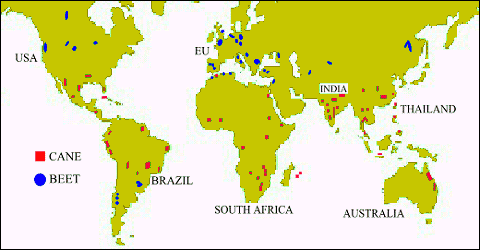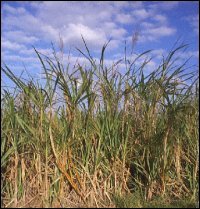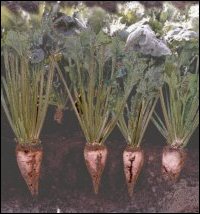How Sugar is Made - an Introduction
Sugar is produced in 121 Countries and global production now exceeds 120 Million tons a year. Approximately 70% is produced from sugar cane, a very tall grass with big stems which is largely grown in the tropical countries. The remaining 30% is produced from sugar beet, a root crop resembling a large parsnip grown mostly in the temperate zones of the north.  An interactive World Map of Sugar production. Click on an area to learn more about it! What we call sugar, the chemist knows as 'sucrose', one of the family of sugars otherwise known as saccharides in the grouping called carbohydrates. Carbohydrates, as the name implies, contain carbon and hydrogen plus oxygen in the same ratio as in water. The saccharides is a large family with the general formula CnH2nOn. The simplest of the sugars is glucose, C6H12O6, although its physical chemistry is not that simple because it occurs in two distinct forms which affect some of its properties. Sucrose, C12H22O11, is a disaccharide, a condensation molecule made up of two glucose molecules [less a water molecule to make the chemistry work]. The process whereby plants make sugars is photosynthesis. The plant takes in carbon dioxide from the air though pores in its leaves and absorbs water through its roots. These are combined to make sugar using energy from the sun and with the help of a substance called chlorophyll. Chlorophyll is green which allows it to absorb the sun's energy more readily and which, of course, gives the plants' leaves their green colour. The reaction of photosynthesis can be written as the following chemical equation when sucrose is being made:
This shows that oxygen is given off during the process of photosynthesis. Historically, sugar was only produced from sugar cane and then only in relatively small quantities. This resulted in it being considered a great luxury, particularly in Europe where cane could not be grown. The history of man and sugar is a subject in its own right but suffice to say that, even today, it isn't easy to ship food quality sugar across the world so a high proportion of cane sugar is made in two stages. Raw sugar is made where the sugar cane grows and white sugar is made from the raw sugar in the country where it is needed. Beet sugar is easier to purify and most is grown where it is needed so white sugar is made in only one stage. To read more about the history of the industry and see how the various processes work with the final results, the sugar we buy, click on the appropriate tab at the top of the page. Within each page there are also links to further sites with more detailed information.
 
Sugar Cane The cane itself looks rather like bamboo cane and it is here that the sucrose is stored. In the right climate the cane will grow in 12 months and, when cut, will re-grow in another 12 months provided the roots are undisturbed. A typical sugar content for mature cane would be 10% by weight but the figure depends on the variety and varies from season to season and location to location. Equally, the yield of cane from the field varies considerably but a rough and ready overall value to use in estimating sugar production is 100 tons of cane per hectare or 10 tons of sugar per hectare.  
Sugar Beet A typical sugar content for mature beets is 17% by weight but the value depends on the variety and it does vary from year to year and location to location. This is substantially more than the sucrose content of mature cane but the yields of beet per hectare are much lower than for cane so that the expected sugar production is only about 7 tons per hectare. The World of Sugar Production : Mid 1990's








|